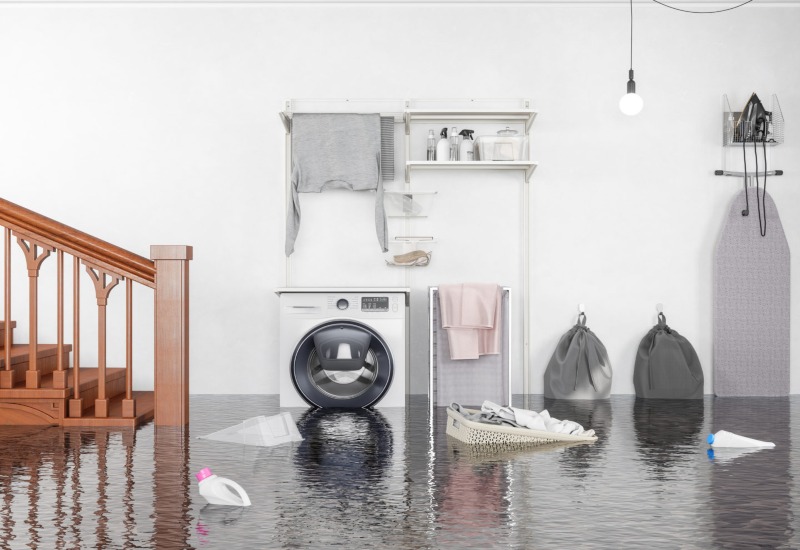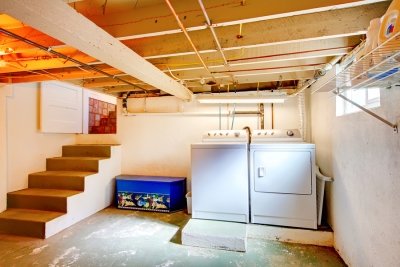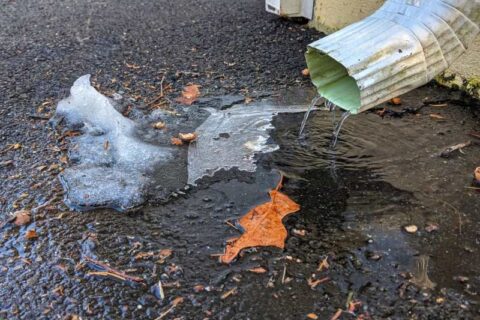How to Avoid a Flooded Basement
 A flooded basement is one of the worst nightmares of any homeowner. When the basement floods, the water can ruin furniture, give mold a comfortable place to grow, and even cause structural damage. If you’ve got a finished basement, you’ll want to take steps to keep all that from happening. How can you avoid a flooded basement? Take steps to waterproof your basement.
A flooded basement is one of the worst nightmares of any homeowner. When the basement floods, the water can ruin furniture, give mold a comfortable place to grow, and even cause structural damage. If you’ve got a finished basement, you’ll want to take steps to keep all that from happening. How can you avoid a flooded basement? Take steps to waterproof your basement.
First, determine potential problems that could lead to water flowing into your basement. Basement flooding often occurs because of surface water running down the foundation walls, or groundwater in saturated soil being pushed into the basement. Storm sewer water from the municipal storm sewer system backing up into the perimeter foundation drain can leak into the basement, or a clog in a sewer line can cause water to come up through sink and floor drains on the lower levels of your home. With all these possible ways for water to come into your basement, what can you do to protect your home?
If you’ve never had water problems in your basement before, the problem may be surface water. Look for water draining down next to your foundation, because if it’s coming in only at the exterior foundation wall or just in one location, you’ve probably got surface water trouble. Go outside and look for one of these possible sources.
- Gutters that aren’t working properly can cause problems for your basement. They might be full of leaves and debris, in which case cleaning them more frequently or installing gutter guards may resolve your issue.
- On the other hand, the problem might be your downspouts. If water overflows your gutters in the rain, it will run down next to the house’s foundation. Even if it’s not getting into the basement, water around your foundation is a problem, because it can erode the soil. This can lead to cracking in your walls and ceilings. If your downspouts are the issue, the solution may be to add another downspout. This way, if one downspout is blocked, the additional one can act as a backup.
- The distance of the downspouts is also important. They should extend at least 10 feet from the house. You may not find this aesthetically pleasing, but it’s the minimum distance necessary to carry the water from your roof and away from your house.
- The pavement by your house could be bringing water to your basement. Even if the pavement was originally placed correctly, it can settle over time. If it’s sloping in a direction that allows water to flow toward the house, the paving will need to be removed and replaced so that it is angled away from the house. On the other hand, the problem with the pavement could be that the sealant around it is cracked. In that case, you’ll need to have the sealant removed or replaced.
- The slope of the pavement is not the only slope to watch. The land around your home should slope away from the house. Check the ground next to your foundation walls, and look for depressions in the ground. These will need to be filled so that the water can drain away from the house. There also needs to be at least eight inches between the top of the ground and any stucco or wood on your house. Sometimes the problem is not necessarily with your yard. If you think that nearby hills could be the issue, you may need to contract the services of a civil engineer.
- Your irrigation could be causing the problem. It’s best to keep lawn irrigation away from the house. If it must be near the house, make sure the water dispersed next to the house is limited, and that the system doesn’t turn on when it’s been raining.
If one of these things turns out to be the issue, good! You’ve solved the problem. On the other hand, if you can’t easily find the source of the water, your issue may be below the surface. Subsurface problems are harder to determine and more expensive to fix. Sometimes, the groundwater outside the basement rises above the level of the basement floor, causing water to leak through any hairline cracks in the basement walls or floor. With older houses, sometimes the perimeter foundation drain system is connected directly into the city storm sewer system. In this situation, storm water sometimes backs up into the drain system, saturating the soil around the house, which causes water to leak into the basement.
Ultimately, any subsurface water that’s getting into the basement is best controlled with a drain system. A perimeter above-slab gutter system can be installed at the base of the exterior foundation walls, on top of the floor slab, doubling as a base material for the wall. Another type of drain is the below-slab perimeter drainage system. This kind of system requires partial removal of the concrete floor slab and installation of a drainage pipe, so it’s more involved and more expensive than the base gutter system. On the other hand, the below-slab system is typically a more effective system.
One of the worst things that can happen to your basement is a sewage backup. Sewer backups can be caused by municipal sewer systems that become overwhelmed, or by individual lines being clogged. Sometimes roots get into pipes, pipes break, or the ground becomes saturated, and sometimes sewer mains are clogged because of vandalism. This kind of problem is extremely hazardous, and often out of the homeowner’s control. You can help prevent it by properly maintaining your individual lines and installing backflow protectors. If all else fails, you may need to get the city government involved.
The smartest thing you can do about flooding in your basement is to prevent it from happening in the first place. There are many different ways to waterproof a basement that address both the interior and exterior of the basement. However you choose to do it, the desired result is the same: a basement with no flooding. To accomplish this, holes and cracks will need to be filled, and you’ll need to be sure your drainage system is adequate. Some other options include skin shielding, in which a rubberized skin is placed over the exterior basement wall to keep water out, or installing a water sock, a round piece of material covered in mesh and placed in a trench around the house. There are also waterproofing membranes that can be used to keep water out of the house.
To ensure that your basement is successfully waterproofed, it’s smart to call in an experienced professional. At Budget Waterproofing, we’ve got more than 55 years of experience servicing both commercial and residential customers throughout Maryland. We’re proud of our craftsmanship and confident in our skills, and all of our technicians are fully licensed, insured, and bonded. Whether your problem is moisture, humidity, or mold in your basement, we have the experience and know-how to provide the solution. For more information, call 410.690.4970 or contact us through our website.


